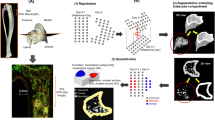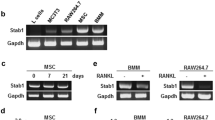Abstract
Src knockout (KO) and RANKL KO mice both exhibit near complete osteopetrosis in terms of 3D-bone volume (BV) fraction by micro-CT, whereas the serum CTX concentration of Src KO is apparently normal and that of RANKL KO is 30% of wild-type (WT) despite the fact that they lack osteoclasts. By histomorphometry we found that, whereas eroded surface (ES) and osteoid surface (OS) are zero values in RANKL KO, they are indistinguishable from WT in Src KO; because of marked increase in bone surface (BS), ES/BS and OS/BS of Src KO are 30–40% of WT. While RANKL KO lack both osteoclasts and osteoblasts, Src KO reveal increased numbers of osteoclasts and indistinguishable numbers of osteoblasts compared with WT; again, on the basis of BS, N.Oc/BS is comparable to WT and N.Ob/BS is markedly decreased in Src KO. The apparently increased number of total osteoclasts may be due to increased expression of RANKL found in Src KO bone in vivo. Src has a gene dosage-dependent effect on osteoclast function in vitro, with Src−/− osteoclasts completely lacking bone-resorbing function as determined by CTX release on dentin. Thus, Src KO osteoclasts retain some bone-resorbing function in vivo. The number of osteocytes is proportionally increased in RANKL KO, while Src KO mice have relative osteocyte deficiency, raising the possibility that RANKL and Src has an unrecognized role in osteocyte survival.









Similar content being viewed by others
References
Teitelbaum SL (2000) Bone resorption by osteoclasts. Science 289:1504–1508
Yoshida H, Hayashi S, Kunisada T, Ogawa M, Nishikawa S, Okamura H, Sudo T, Shultz LD, Nishikawa S (1990) The murine mutation osteopetrosis is in the coding region of the macrophage colony stimulating factor gene. Nature 345:442–444
Soriano P, Montgomery C, Geske R, Bradley A (1991) Targeted disruption of the c-src proto-oncogene leads to osteopetrosis in mice. Cell 64:693–702
Wang ZQ, Ovitt C, Grigoriadis AE, Mohle-Steinlein U, Ruther U, Wagner EF (1992) Bone and haematopoietic defects in mice lacking c-fos. Nature 360:741–745
Iotsova V, Caamano J, Loy J, Yang Y, Lewin A, Bravo R (1997) Osteopetrosis in mice lacking NF-kappaB1 and NF-kappaB2. Nat Med 3:1285–1289
Kong YY, Yoshida H, Sarosi I, Tan HL, Timms E, Capparelli C, Morony S, Oliveira-dos-Santos AJ, Van G, Itie A, Khoo W, Wakeham A, Dunstan CR, Lacey DL, Mak TW, Boyle WJ, Penninger JM (1999) OPGL is a key regulator of osteoclastogenesis, lymphocyte development and lymph-node organogenesis. Nature 397:315–323
Henriksen K, Bollerslev J, Everts V, Karsdal MA (2011) Osteoclast activity and subtypes as a function of physiology and pathology–implications for future treatments of osteoporosis. Endocr Rev 32:31–63
Amling M, Neff L, Priemel M, Schilling AF, Rueger JM, Baron R (2000) Progressive increase in bone mass and development of odontomas in aging osteopetrotic c-src-deficient mice. Bone 27:603–610
Marzia M, Sims NA, Voit S, Migliaccio S, Taranta A, Bernardini S, Faraggiana T, Yoneda T, Mundy GR, Boyce BF, Baron R, Teti A (2000) Decreased c-Src expression enhances osteoblast differentiation and bone formation. J Cell Biol 151:311–320
Martin T, Gooi JH, Sims NA (2009) Molecular mechanisms in coupling of bone formation to resorption. Crit Rev Eukaryot Gene Expr 19:73–88
Matsumura H, Hasuwa H, Inoue N, Ikawa M, Okabe M (2004) Lineage-specific cell disruption in living mice by Cre-mediated expression of diphtheria toxin A chain. Biochem Biophys Res Commun 321:275–279
Fumoto T, Takeshita S, Ito M, Ikeda K (2014) Physiological functions of osteoblast lineage and T cell-derived RANKL in bone homeostasis. J Bone Miner Res 29:830–842
Ito M, Nakayama K, Konaka A, Sakata K, Ikeda K, Maruyama T (2006) Effects of a prostaglandin EP4 agonist, ONO-4819, and risedronate on trabecular microstructure and bone strength in mature ovariectomized rats. Bone 39:453–459
Bouxsein ML, Boyd SK, Christiansen BA, Guldberg RE, Jepsen KJ, Muller R (2010) Guidelines for assessment of bone microstructure in rodents using micro-computed tomography. J Bone Miner Res 25:1468–1486
Dempster DW, Compston JE, Drezner MK, Glorieux FH, Kanis JA, Malluche H, Meunier PJ, Ott SM, Recker RR, Parfitt AM (2013) Standardized nomenclature, symbols, and units for bone histomorphometry: a 2012 update of the report of the ASBMR Histomorphometry Nomenclature Committee. J Bone Miner Res 28:2–17
Takeshita S, Kaji K, Kudo A (2000) Identification and characterization of the new osteoclast progenitor with macrophage phenotypes being able to differentiate into mature osteoclasts. J Bone Miner Res 15:1477–1488
Nango N, Kubota S, Hasegawa T, Yashiro W, Momose A, Matsuo K (2015) Osteocyte-directed bone demineralization along canaliculi. Bone 84:279–288
Peruzzi B, Cappariello A, Del Fattore A, Rucci N, De Benedetti F, Teti A (2012) c-Src and IL-6 inhibit osteoblast differentiation and integrate IGFBP5 signalling. Nat Commun 3:630
Acknowledgements
We thank M. Okabe for permission to use CAG-Cre mice, and M. Suzuki for technical assistance. This study was supported by JSPS KAKENHI for Scientific Research B (22390064 to K.I.) and for Young Investigator (21790374 to T.F.) and by MEXT KAKENHI for Scientific Research on Innovative Areas (22118007 to K.I.) from the Ministry of Education, Culture, Sports, Science, and Technology of Japan; and by a Grant for Longevity Sciences from the Ministry of Health, Labor, and Welfare of Japan (H23-12 to K.I., S.T. and M.I. and H26-17 to S.T., K.I. and M.I.).
Author information
Authors and Affiliations
Corresponding author
Ethics declarations
Conflict of interest
The authors declare no competing financial interests.
About this article
Cite this article
Takeshita, S., Fumoto, T., Ito, M. et al. Serum CTX levels and histomorphometric analysis in Src versus RANKL knockout mice. J Bone Miner Metab 36, 264–273 (2018). https://doi.org/10.1007/s00774-017-0838-3
Received:
Accepted:
Published:
Issue Date:
DOI: https://doi.org/10.1007/s00774-017-0838-3




